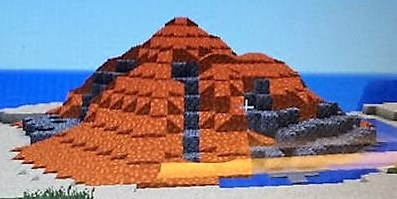A guest post from Dr Laura Hobbs, Science Hunters Outreach Coordinator
Science Hunters is an outreach project based in Lancaster Environment Centre, Lancaster University. We use Minecraft to engage children with science and help them learn about topics not usually covered in science lessons, so it’s a great opportunity to introduce some Earth Science themes.
The basic idea of Minecraft is that players can create constructions by breaking and placing textured blocks; rather like Lego but on a computer. It’s an ‘open world’ game, which means that players are free to roam around its virtual world. We use a version specially produced for educational use, ensuring play in a safe environment, and operate the game in ‘creative’ mode so that players have unlimited blocks to build with. It’s very popular with children and adults alike and is a great way to attract children to science learning exercises, as they’re drawn in by the opportunity to play the game. This can be a chance to try it out or play it on a different IT platform than the one they’re used to, and if they’re very experienced with the game children can feel a sense of expertise and ownership as they advise others on how to progress and get the most out of their play.
We deliver sessions in primary and secondary schools, at community events and at our on-campus Minecraft Club which we run with the local National Autistic Society. We cover a variety of topics informed by the research skills of the Science Hunters team – my background is geology/volcanology and so of course those areas are on offer. Volcanoes are a hugely popular topic for in-school delivery, and we’ve also covered caves and minerals and dinosaurs in our Minecraft Club sessions.
Minecraft is an excellent for engaging children with science learning as it allows them to explore science topics by comparing what happens in the game with real-world processes. For example, just as in the real world, obsidian forms in Minecraft when the source block of a lava flow (the hottest part of the flow, which has not had time to cool down in the air) comes into contact with water. Other parts of the lava flow solidify when touched by water, but form crystalline blocks instead. These parallels with the real world help children to understand and remember the processes involved; I use the nature of the blocks formed at various points of the Minecraft lava flow when it interacts with water to help explain differences between crystalline rocks and volcanic glass, crystal sizes and growth rates and subaerial and subaqueous cooling. Engaging with lava-water interactions in Minecraft and the opportunity to handle real volcanic rock hand samples also raises students’ awareness of and interest in a topic which is not usually covered in their formal education unless they choose to study relevant subjects at a higher level.
We’re getting great feedback about the positive effects of using Minecraft for informal science learning delivery, with benefits reported for children’s learning, confidence and communication skills, and about the ‘Volcanoes’ topic as an effective hook for capturing their interest. With additional resources such as the British Geological Survey’s 2D and 3D geological Minecraft maps and the Geological Survey of Sweden’s Minecraft modification BetterGeo, Minecraft is showing more and more potential as an Earth Science learning tool for the future.
- If you’d like to find out more about Science Hunters please see our webpage (including a video of an erupting Minecraft volcano!), visit us on Facebook or email us on sciencehunters[at]lancaster.ac.uk.

Minecraft is great at teaching geology as well as many other science branches. Do you guys know if the Education edition is available to the public or is it just limited to schools?